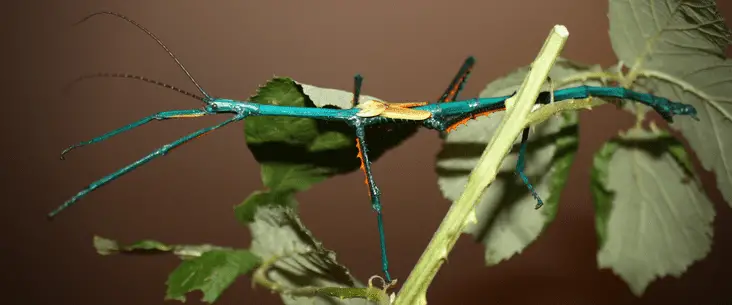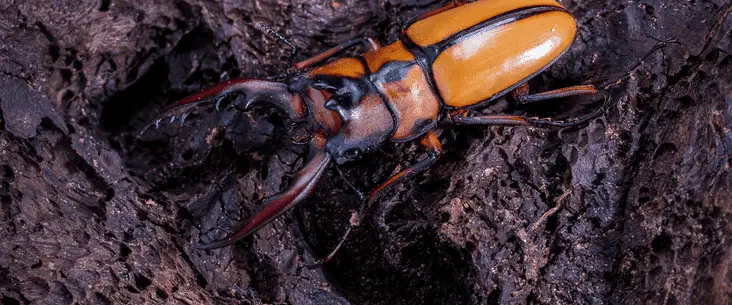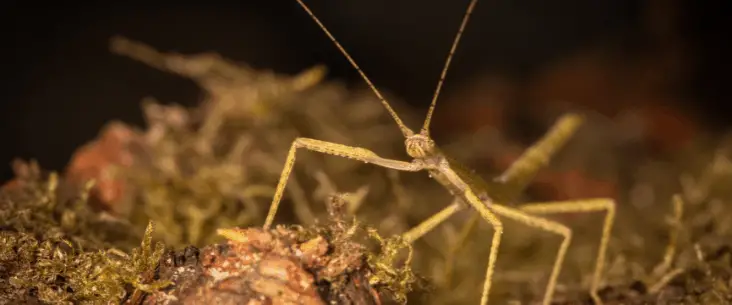This impressive species is a very large and sturdy stick insect. Pharnacia ponderosa does not have an official English name, but is often called as ‘giant walking stick’ or ‘heavy stick insect’. And large they are, especially the females who can get up to 21cm of body length.
Unfortunately, this species native to the Philipines (Samar Island) is not kept much as pets. It is a shame because it is a very easy going stick insect and breeding with them is quite easy. Although, you need to take into account that these stick insects need a relatively large enclosure.
We will discuss in this practical care guide how you need to take care of this beautiful and large stick insects. We will talk about housing, creating a proper environment, how to feed them, the cleaning routine and discuss some breeding tips. First, let’s have a look at this amazing species.
About the giant walking stick
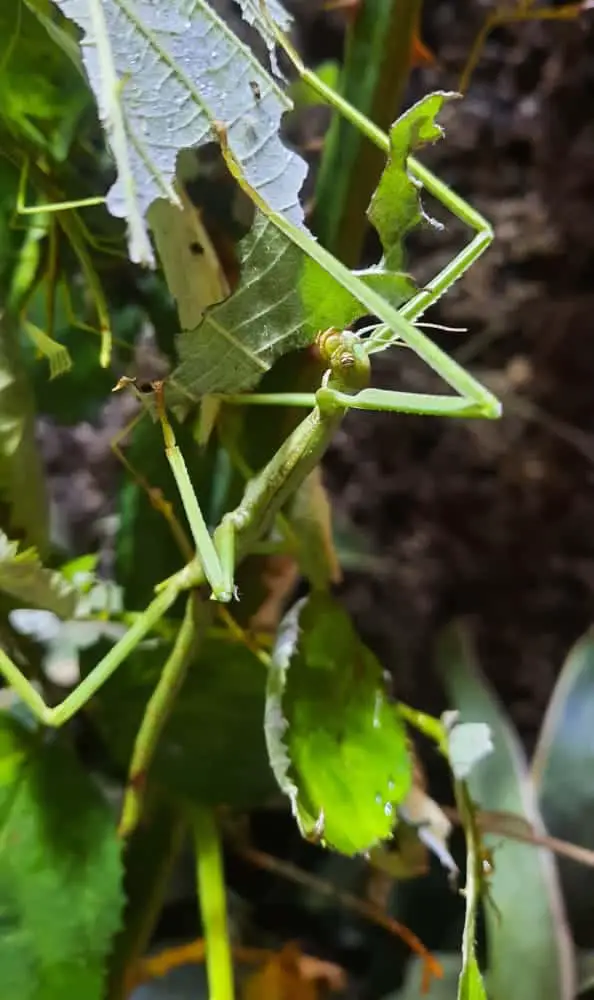
Appearance
Females are big and have a thick heavy-build body. Their main colour is green, but vary between bright green to green-brown and green-grey. They are often covered with darker brown spots. They have a typical stick insect head, and with females, the head is also quite large. Females lack wings completely.
Males are much smaller, mostly around 13cm (5″) and are thin-bodied. They are more green-brown coloured and have some brown spots on their body. The males have fully developed wings, although when they try to fly it is very clumsy. Males also have many small spines on the legs, where females lack or have lesser spines.
Newly hatched nymphs are always bright green, and even when eggs are of a regular size (5mm), the nymphs are big and can be up to 2,5 cm (1″)
Behaviour, temperament and handling
Pharnacia ponderosa is quite docile, and especially the nymphs up to L3 are easy to handle. From L4 to an adult, they may be quite nervous. When they feel threatened, but also when you try to handle them, they display defensive behaviour in which they drop to the ground and start wriggling wildly with the legs. When adult males feel threatened, they sometimes begin fluttering with their wings. They also display the typical rocking/waving behaviour when they feel threatened. As camouflage, they mimic a branch moving in the wind.
Although they are large and sturdy, even the adults are quite fragile. When handling, you need to be very careful that they don’t lose a limb. Although it can regrow within successive moults, it is a bit of a shame when they lose it, and it makes it more difficult for them to move around. When you handle them go carefully that they don’t let themselves drop off your hand and fall a great distance, damaging the stick insect or even kill it.
Housing requirements
These stick insects have no high demands on their housing. However, Pharnacia ponderosa is a large stick insect, so the enclosure should also be relatively big. The height of the enclosure is more important than the width. The enclosure should have a height of at least three times the body length. This means the enclosure should be at least 60cm (23″) high, but I can recommend to keep them in an enclosure of 90cm (35″) because it will soon be overcrowded. The width should be at least two times the body length and needs to be around 40cm to 50cm (15″- 20″). If you have more than five female adults with several males and nymphs, you should soon be looking at even a larger enclosure.
Some brands have pre-build terrariums that are very suitable for this species, like ‘Exo Terra‘, ‘Zoo Med‘ and ‘Repti Zoo‘. Netting cages can also work perfectly for this species, although visibility to your animals is better when having a glass enclosure.
A fair amount of ventilation is very important when keeping these stick insects. Without enough ventilation, the humidity may build up and causes problems such as moult and bacteria growth. These problems will cause health issues to your animals. An enclosure with netting on the top of the enclosure is very helpful for Pharnacia ponderosa to moult.
You should provide some branches in the enclosure as a climbing structure and for them to use to moult. Within a glass terrarium, it is good to have some branches from the bottom to the top so that when they fall on the bottom, they can climb up again. Although nymphs of this species are known to walk on glass, it seems like adults are unable to do that and surely need those branches. Don’t place too many branches but leave the space in the middle open for feeding plants (see section: feeding practice). Cork on the sides is also used to make it easier to climb on and helps to keep the humidity stable.
A substrate is not explicitly necessary but is highly recommended for two reasons. First, it will help to keep the humidity stable. Second, it will keep the animals from damaging when they drop to the bottom. As described before, they can be pretty nervous, and as a defence mechanism, they let themselves drop when feeling threatened. The best products to use as a substrate are white (aquarium/river) sand or coconut fibre. Other materials that are used are leaves, potting soil and vermiculite. For leaves and potting soil, the downside is that it develops mould more quickly, and leaves do not absorb moisture that well. With vermiculite, it is more difficult to find and collect eggs (see section: breeding tips).
Environmental conditions
You can keep this stick insect species at room temperature. The prefered temperature range is between 22°C and 26°C (72°F – 79°F), but they don’t need to be kept explicitly that warm and can very well adapt to lower end of the range up to 20°C (68°C). Night temperatures may even drop to a minimum of 15°C (59°F).
If you want to place the stick insects in a room where the temperature is lower than the recommended temperature range, you should use additional heating. A regular lightbulb of around 25W is often proficient. You can set the heating time 12 hours on and 12 hours off with a timed switch, so the animals don’t have continuous light in their enclosure. They are nocturnal, and they must have sufficient dark hours. If heating is not necessary, then they don’t need an additional light source when there is natural light in the room. However, don’t place the enclosure in direct sunlight. Direct sunlight will quickly cause overheating of your enclosure and your animals.
Pharnacia ponderosa doesn’t have very high demands on humidity, but they prefer a somewhat humid environment between 60% and 80%. So you need to mist spray water once in a while (once a week should be fine). If you use a substrate, you can dampen it by spraying water on it. Make it damp, not wet. When you use a heating source, you probably have to spray a bit more frequently, at least when the substrate is completely dry. When you feed the animals their plant food, it can be useful to spray it lightly before placing it in the enclosure. Additionally, this is good for the humidity, and it also provides drinking water. Be careful not to make the enclosure to wet to prevent the growth of mould and bacteria.
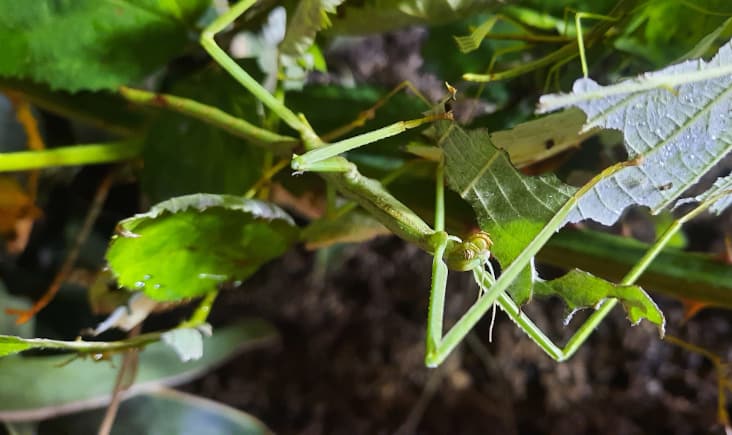
Feeding practice
Pharnacia ponderosa is herbivorous, like all phasmid, and only eat leaves of certain plants. Suitable plants that you can feed them are bramble (blackberry), oak, beech and eucalyptus. In my experience, they like bramble the most. You can get bramble almost everywhere, from growing unwanted in your garden up to parks and in forests. Even with slight freezing bramble will keep on their leaves. When it is cold outside (below 10°C / 50°F) let the leaves warm up for a moment before feeding them.
You need to feed them fresh leaves every two to four days, depending on how much you have fed last time and how much they eat. If the stick insects have eaten all leaves of the plant, or when the leaves/plant have dried out, you should refresh the food. Stick insects need fresh leaves available at all times. Also, be aware that especially females can eat quite a lot. But that should not be a surprise if you see how big and heavy they can become.
When you collect the plant from outside, only cut what you tend to feed. Although they only eat the leaves, they use the branches and stems of plants you provide to climb and sit on to rest, or sometimes to moult. Cut pieces of the stems with leaves (and not only collect the leaves) and place it in the enclosure. To keep the plant leaves fresh longer, you should place them in a bottle or vase filled with water. When the bottle/vase is lightweight, you should fill the vase/bottle with sand or rocks to make it heavier, so it doesn’t fall over or dig it in the substrate.
Spray the leaves before you place them in the enclosure, and lightly spray them after two days. This way, you keep the leaves fresh for a longer time, and it provides drinking water for the stick insects. A water bowl is not recommended. Pharnacia ponderosa does not drink from a bowl, and it makes a risk that smaller nymphs will drown in it.
When you want or need to buy these plants to feed them, be aware that they might be sprayed with insecticides, and this will quickly keel your animals. Always ask explicitly that the plants are free of insecticides or any other chemicals.
Cleaning routine
Cleaning? What cleaning? Yes, that’s right, caring for Pharnacia ponderosa includes almost no cleaning at all and don’t cost much time. Most cleaning you should do is remove old shed skins and old/dried leaves daily. Once every two or three weeks, you need to do a more extensive cleanup and remove all dirt and frass/droppings. When having a substrate, you can periodically refresh (parts of) the substrate. I also collect the eggs every two or three weeks to breed them separately, although they can also be left in the enclosure and left them there. These nymphs do pretty well in the enclosure where also the adults live.
When one of your animals died, you should always inspect it for abnormalities like injuries or if you see anything strange on them. You should always keep an eye out for mould or pieces of old skin that kept stuck on the animal.

Breeding tips
Recommended read: Basics of breeding phasmids
If you want to know all about breeding phasmids (stick insects and leaf insects) you should check out the helpful guide on how to breed phasmids. It discusses the basics, techniques and provides many practical tips.
Breeding Pharnacia ponderosa is as easy as putting males and females together and creating a proper habitat condition. Soon you will see the first eggs laying on the bottom of your enclosure. There is not much to it.
This species of stick insect lay a lot of eggs in her 10 to 14 months of lifespan. Females will typically get a bit older than males. The eggs are just dropped to the ground in the enclosure.
I prefer to collect the eggs and use a separate enclosure for incubating and hatching eggs. After their first moult (so in stage L2, sometimes L3) I transfer the nymphs back to the adults. Newly hatch nymphs can use a higher humidity by putting a moist substrate or kitchen towel in the incubation enclosure. But also be sure that the enclosure has proper ventilation to prevent the development of mould. Mould will reduce the success rate of hatchings. Keeping the eggs at room temperature (around 20°C to 23°C / 68°F – 73°F) seems like the best incubation temperature. Incubation of the eggs is about 4 to 4,5 months.
Share this page!

